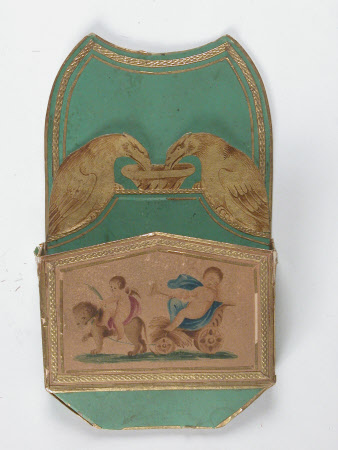Card-rack
Category
Household and miscellaneous
Date
circa 1820
Materials
Cardboard and paper
Measurements
190 x 110 x 25 mm
Place of origin
France
Order this imageCollection
Attingham Park, Shropshire
NT 610046.2
Caption
This French card-rack, made of cardboard with stamped gilt borders, hails from a time when the social etiquette of visiting was an art form in and of itself. It is one of a group of Regency card-racks that may have belonged to Sophia, wife of the 2nd Lord Berwick. Sophia was a courtesan when she married Lord Berwick in 1812; she was 17 and he was 42. Card-racks such as this example were often part of a pair; the matching racks were hung on either side of a mantelpiece. The card pocket, decorated here with a putto reclining in a lion-drawn chariot, was used to hold the calling cards of friends and acquaintances. The practice of exchanging calling cards originated in France and soon became popular in aristocratic English households where servants greeted visitors, proffering a tray upon which an embossed card might be deposited. The French artist Jean-Auguste-Dominique Ingres (1780-1867) included calling cards in his portraits of elegant, aristocratic women. In his portrait of the Comtesse d'Haussonville (The Frick Collection, New York), a group of dog-eared calling cards are scattered on the mantelpiece, an indication of unconsummated visits. In his portrait of Madame de Senonnes (Musée des Beaux-Arts, Nantes), Ingres’s own calling card is one of several tucked in the mirror frame behind the fashionable sitter, his signature partially visible. Card-racks therefore presented a storage solution to the surfeit of printed ephemera that might accumulate on one’s mantelpiece. In this way they were a handy and potentially ostentatious repository not just for calling cards, but letters and invitations - a visible display of a lady’s social network. While this card-rack was made in France, some were commercially produced in Britain. The publisher and lithographer Rudolph Ackermann also manufactured ‘fancy articles’, including card-racks. The German-born Ackerman employed French émigrés to manufacture them, along with screens, flower stands and other ornaments which he sold in his shop on the Strand: a truly Anglo-European enterprise.
Summary
One of a pair of cardboard card-racks with rectangular green backplate and slanting pocket to front. Decorative putto reclining in chariot pulled by a lion ridden by a second putto and details picked out in colour. Surmounted by two eagles drinking out of a dish. Stamped gilt paper borders. Made in France, circa 1820.
Provenance
Attingham collection; bequeathed to the National Trust with the estate, house and contents of Attingham by Thomas Henry Noel-Hill, 8th Baron Berwick (1877-1947) on 15th May 1953.
References
Kay 2011: Sarah Kay, "Social Networking 19th-Century Style", National Trust Arts/Buildings/Collections Bulletin, Autumn Issue, October 2011, pp.6 - 7
